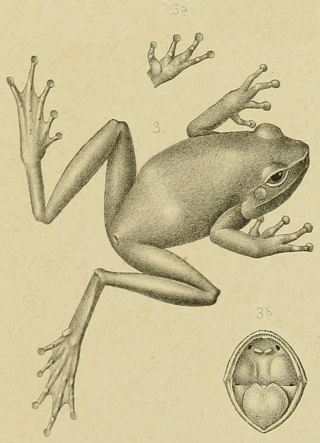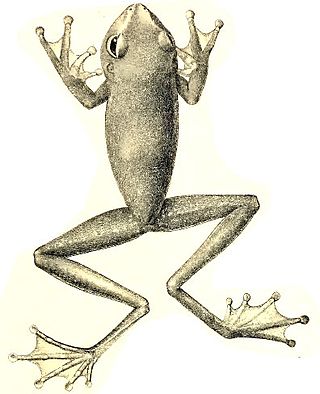
Count Adelardo Tommaso Salvadori Paleotti was an Italian zoologist and ornithologist.

The yellow-billed kingfisher(Syma torotoro) is a medium-sized tree kingfisher.

The chestnut-naped spurfowl is a species of bird in the pheasant family Phasianidae. At 33–37 cm (13–15 in) in length and weighing 550–1,200 g (19–42 oz), it is a large species of spurfowl. It is found in Ethiopia and Somaliland. The population is believed to be stable but according to the International Union for Conservation of Nature (IUCN) there is insufficient data to make an estimate of the population.

The Fly River grassbird is a species of Old World warbler in the family Locustellidae. It is found in Indonesia and Papua New Guinea. Its natural habitats are freshwater marshes and lakes. It is threatened by habitat loss.

The Wahai tree frog is a species of frog in the subfamily Pelodryadinae, endemic to Indonesia and known from the Vogelkop Peninsula in the north-western New Guinea, and from the Seram Island, one of the Maluku Islands. Little is known about this lowland species that has not been collected after it was described in 1878.

Nyctimystes montanus is a species of frog in the subfamily Pelodryadinae. It is endemic to the Arfak Mountains, located in the Bird's Head Peninsula of northwestern New Guinea. This species is only known from its type locality. There are no records of this species after it was described in 1878, perhaps because of lack of surveys.
The Rufescent Imperial Pigeon, also known as the Shining Imperial Pigeon, is a rare species in the world of birds. According to The International Union for Conservative, this species is relatively unknown, and their concern is very minimal. The Union describes that this species is very stable and does not encounter threats from other species The trait of stability is vital in differentiating The Rufescent Imperial Pigeon from the other species confronting threats. This bird in specific does not frequently encounter threats because they are more reserved, quiet birds that tend to remain alone in their habitat. The habitat of these birds allows them to have the frequency of being independent but also gives them the chance to be with other birds. Rooting from the bird family in Columbidae, that also consists of pigeons and doves. In which this family is known for being frugivorous, meaning it primarily feeds on fruit, figs, and seeds.

The ornate fruit dove is a species of bird in the family Columbidae. It is found in New Guinea. Its natural habitats are subtropical or tropical moist lowland forest and subtropical or tropical moist montane forest.

The crested cuckoo-dove is a species of bird in the pigeon family, Columbidae. First described by English zoologist John Gould in 1856, it is endemic to the Solomon Islands archipelago, where it mainly inhabits hill forests at elevations of 500–900 m (1,600–3,000 ft). It is a large and robust pigeon, with a length of 40–42 cm (16–17 in) and a distinctive pale purplish-grey crest. Adults are mainly bluish-grey, with a pale greyish-buff throat, blackish tail, and yellow-tipped reddish bill. Both sexes look alike. Juveniles lack the crest, have darker heads, and have duller wings.

The moustached kingfisher, also called Bougainville moustached kingfisher, is a species of bird in the family Alcedinidae. It is endemic to Bougainville Island in Papua New Guinea. An estimated 250–1,000 mature individuals are left.

The forest kingfisher, also known as Macleay's or the blue kingfisher, is a species of kingfisher in the subfamily Halcyoninae, also known as tree kingfishers. It is a predominantly blue and white bird. It is found in Indonesia, New Guinea and coastal eastern and Northern Australia. Like many other kingfishers, it hunts invertebrates, small frogs, and lizards.

The black-throated robin is a species of passerine bird in the Australisian robin family Petroicidae. It is found on the island of New Guinea. Its natural habitat is subtropical or tropical moist montane forests at 1,150–2,750 metres above sea-level.

The New Guinea snake-necked turtle is a species of turtle in the family Chelidae. The species is found almost exclusively within Western Province, Papua New Guinea.

The Biak roundleaf bat or Geelvinck Bay leaf-nosed bat is a species of bat in the family Hipposideridae. It is endemic to the Biak Islands and Cenderawasih Bay area of Papua Province, located in Western New Guinea, Indonesia.

Agrionoptera longitudinalis biserialis known as the striped swampdragon is a subspecies of dragonfly in the family Libellulidae. It is found in Australia and New Guinea. Its usual habitat is in the vicinity of shaded pools and tree holes.

D'Albertis' python, also known commonly as D'Albert's water python or the northern white-lipped python, is a species of python, a non-venomous snake in the family Pythonidae. The species is endemic to New Guinea. There are no subspecies that are recognized as being valid.
Hadrotarsus is a genus of spiders in the family Theridiidae that was first described by Tamerlan Thorell in 1881.

Charmosynopsis is a genus of parrots in the family Psittaculidae that are endemic to New Guinea, the southern Maluku Islands.
Conothele doleschalli is a species of mygalomorph spider in the Halonoproctidae family. It is found in Australia and New Guinea, and was described in 1881 by Swedish arachnologist Tamerlan Thorell.
The pink-breasted flowerpecker is a species of bird in the family Dicaeidae that is native to the south and southeast Maluku Islands of Indonesia. It was formerly considered a subspecies of the mistletoebird.

















